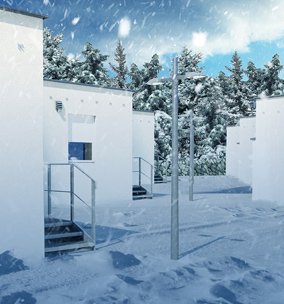


A building's indoor climate has a major effect on the health of its users. Essential conditions for a comfortable and healthy indoor climate are room temperature and relative humidity.
Ideally, this should be between 40 and 60 %. The links between building materials and indoor climate in real conditions, and the ways in which it is possible to influence indoor air humidity and room temperature by using construction techniques, are investigated in projects and studies at the Viva Research Park

How can interior plaster and thermal insulation be used to influence
the air humidity in indoor spaces?

To find out how well different wall structures can store moisture, special measurements of indoor humidity were taken over several weeks at the Viva Research Park. Normal user behaviour (cooking, showering, ventilation, etc.) was simulated in the houses using air humidifiers and a defined air supply.
Results
– Mineral, breathable, lime-based coatings buffered excess moisture most effectively and fastest and were therefore the most effective at ensuring a well-balanced indoor climateThe measurements were supervised and evaluated by the University of Applied Sciences Burgenland, Austria
Project period: 2015 – 2017
Which wall materials ensure pleasant room temperatures?

How warm or cold we find a room depends on the operative temperature (perceived temperature). This is defined by the factors air temperature and surface temperature (radiation). To find out which construction types provide the best protection against winter cold and summer heat, the surface temperatures of the interior walls of the research houses were continuously measured and analysed over one winter period and two summer periods.
Results – surface temperature fluctuations:
– Concrete houses, demonstrated the lowest fluctuations
– Brick houses and the timber block house had medium fluctuations
– Houses with a wood frame construction had high fluctuations
– The uninsulated brick house showed the highest fluctuation range
The lower the temperature fluctuations, the more balanced the indoor temperature. In addition to measuring the surface temperatures, the changes in indoor temperature in the different seasons of the year were also determined. The measurements were supervised and evaluated by the University of Applied Sciences Burgenland, Austria
Project period: 2015 – 2017

Results – Room temperatures:
During the extremely hot summer of 2015, when the air temperature reached up to 36°C, the insulated houses showed indoor temperatures up to 5°C lower than the uninsulated house.
Indoor temperatures measured in the houses (average values):
– Houses made from brick or concrete (with insulation) – 26°C (value within the comfort zone)
– Timber block house 28°C
– Wood frame construction 29°C,
– Brick house (uninsulated) - 30°C.
As well as thermal insulation, the storage mass of wall constructions has a crucial effect on room temperature. The measurements at the Viva Research Park confirmed that solid, heavy walls store the heat of the sun during the day and emit it during the colder evening and night hours. This effect guarantees a more stable indoor temperature.

In the winter months, the ways in which a break in heating affects the indoor temperatures in the houses were examined. To do this, the change in temperature was measured in the winter in the event of cold snaps of 0 to -12°C (simulated heating failure of 48 hours).
The following results were obtained after two days:
– Houses built from 25 cm bricks or concrete (with insulation) maintained room temperatures most effectively (15 to 17°C)
– The timber block house, the 50 cm brick house (with mineral wool) and the wood frame houses had indoor temperatures of between 11 and 13°C
– After 48 hours, the brick house (uninsulated) had a room temperature of just 4°C.
The measurements were supervised and evaluated by the University of Applied Sciences Burgenland, Austria
Project period: 2015 – 2017
How does a healthy indoor climate affect our well-being?

In an indoor air quality analysis (based on room temperature and relative humidity), scientists from the Medical University of Vienna evaluated the indoor climate-related and structural factors of each building in terms of their effects on comfort and well-being
The result of the environmental medical analysis was clear: the construction type and the choice of building materials have a marked effect on comfort.
– The highest level of comfort was achieved by the insulated houses built from concrete, brick (25 cm) with mineral coating (plaster) and the timber block house
– The insulated wood frame houses and the 50 cm brick house were in the middle
– Only the uninsulated house failed to meet the high standards of Austrian building regulations, and therefore demonstrated only a low level of comfort.
– The uninsulated brick house showed the highest fluctuation range
The measurements were supervised and evaluated by the University of Applied Sciences Burgenland. The evaluation of the effects of indoor climate-related and structural factors on comfort and well-being was carried out by the Medical University of Vienna.
Project period: 2015 - 2017
Ši svetainė naudoja slapukus, kad užtikrintų geriausią naršymo patirtį mūsų svetainėje. Privatumo politika